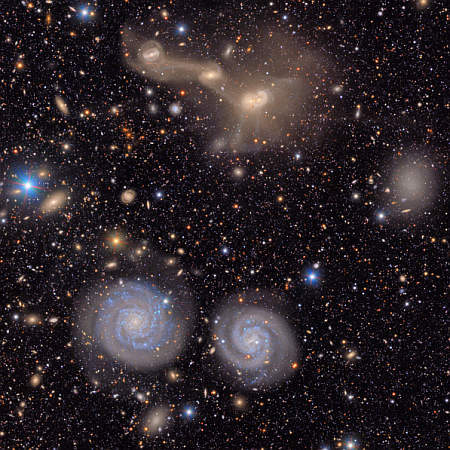The new Rubin telescope releases its first images

Click to see all first look images.
The new Vera Rubin telescope, located in Chile and designed to provide a high resolution survey of the southern sky every three nights, has now released its first images.
Rubin Observatory will … be the most efficient and effective Solar System discovery machine ever built. Rubin will take about a thousand images of the Southern Hemisphere sky every night, allowing it to cover the entire visible Southern sky every three to four nights. In doing so, it will find millions of unseen asteroids, comets and interstellar objects. Rubin will be a game changer for planetary defense by spotting far more asteroids than ever before, potentially identifying some that might impact the Earth or Moon.
The image to the right, cropped, reduced, and sharpened to post here, shows a small section of the Virgo cluster of galaxies, about 50 million light years away.
The telescope’s vast survey data of the sky will also be used to attempt to determine the nature of both dark matter and dark energy.
On Christmas Eve 1968 three Americans became the first humans to visit another world. What they did to celebrate was unexpected and profound, and will be remembered throughout all human history. Genesis: the Story of Apollo 8, Robert Zimmerman's classic history of humanity's first journey to another world, tells that story, and it is now available as both an ebook and an audiobook, both with a foreword by Valerie Anders and a new introduction by Robert Zimmerman.
The print edition can be purchased at Amazon or from any other book seller. If you want an autographed copy the price is $60 for the hardback and $45 for the paperback, plus $8 shipping for each. Go here for purchasing details. The ebook is available everywhere for $5.99 (before discount) at amazon, or direct from my ebook publisher, ebookit. If you buy it from ebookit you don't support the big tech companies and the author gets a bigger cut much sooner.
The audiobook is also available at all these vendors, and is also free with a 30-day trial membership to Audible.
"Not simply about one mission, [Genesis] is also the history of America's quest for the moon... Zimmerman has done a masterful job of tying disparate events together into a solid account of one of America's greatest human triumphs."--San Antonio Express-News

Click to see all first look images.
The new Vera Rubin telescope, located in Chile and designed to provide a high resolution survey of the southern sky every three nights, has now released its first images.
Rubin Observatory will … be the most efficient and effective Solar System discovery machine ever built. Rubin will take about a thousand images of the Southern Hemisphere sky every night, allowing it to cover the entire visible Southern sky every three to four nights. In doing so, it will find millions of unseen asteroids, comets and interstellar objects. Rubin will be a game changer for planetary defense by spotting far more asteroids than ever before, potentially identifying some that might impact the Earth or Moon.
The image to the right, cropped, reduced, and sharpened to post here, shows a small section of the Virgo cluster of galaxies, about 50 million light years away.
The telescope’s vast survey data of the sky will also be used to attempt to determine the nature of both dark matter and dark energy.
On Christmas Eve 1968 three Americans became the first humans to visit another world. What they did to celebrate was unexpected and profound, and will be remembered throughout all human history. Genesis: the Story of Apollo 8, Robert Zimmerman's classic history of humanity's first journey to another world, tells that story, and it is now available as both an ebook and an audiobook, both with a foreword by Valerie Anders and a new introduction by Robert Zimmerman.
The print edition can be purchased at Amazon or from any other book seller. If you want an autographed copy the price is $60 for the hardback and $45 for the paperback, plus $8 shipping for each. Go here for purchasing details. The ebook is available everywhere for $5.99 (before discount) at amazon, or direct from my ebook publisher, ebookit. If you buy it from ebookit you don't support the big tech companies and the author gets a bigger cut much sooner.
The audiobook is also available at all these vendors, and is also free with a 30-day trial membership to Audible.
"Not simply about one mission, [Genesis] is also the history of America's quest for the moon... Zimmerman has done a masterful job of tying disparate events together into a solid account of one of America's greatest human triumphs."--San Antonio Express-News


spotting far more asteroids than ever before
I suppose since asteroids show up as a blinking single-pixel between images they don’t make a good PR photo. But still, if the solar system is its focus, there must be something closer than 50 million light years away to show off.
Mark Sizer: I should have noted that this claim about asteroids is a bit of blarney. Rubin was primarily designed to study the intergalactic medium. Any asteroids it finds will be a bonus.
Rather Van Gogh-ish I’d say.
First Data from Vera Rubin Observatory (June 23, 2025)
Brian Keating interviews Professor Mario Juric
https://youtu.be/GMtJXbV0fHk
52:10